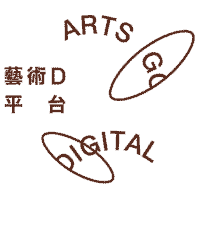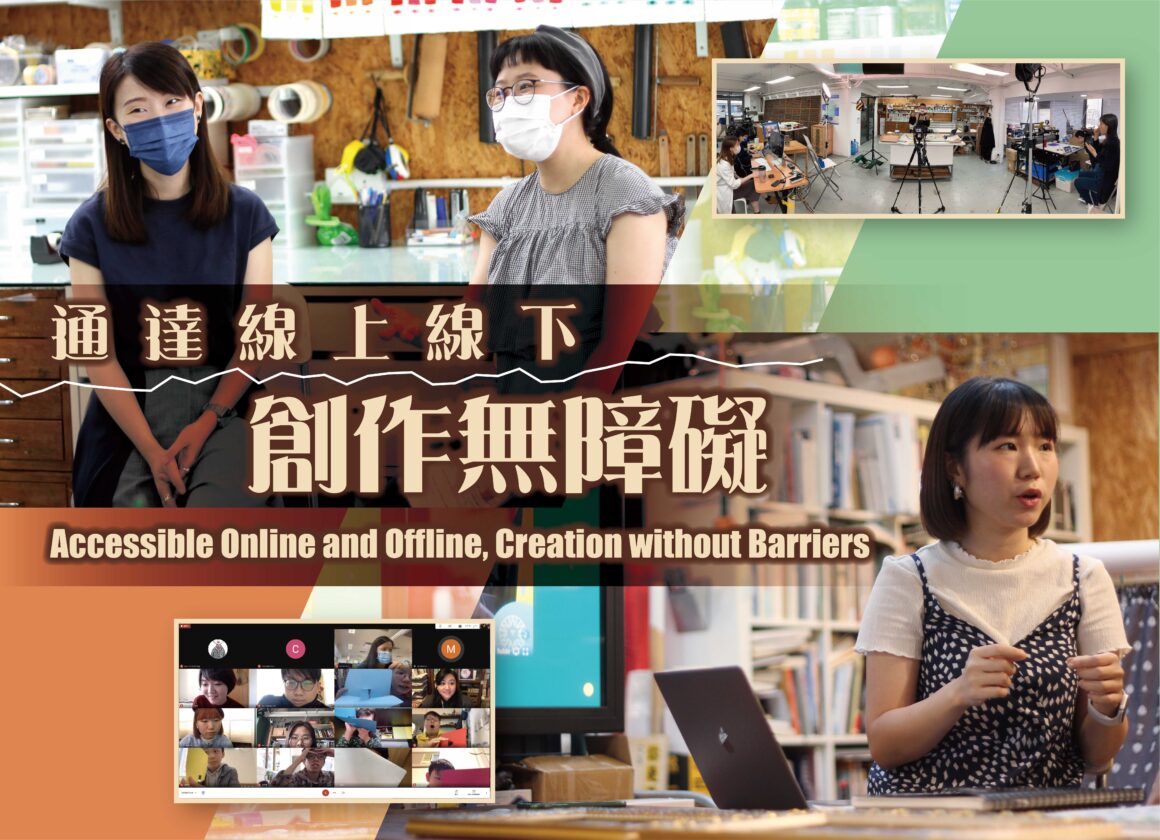“Arts accessibility enabled everyone to participate in the creative process regardless of their differences in needs. The artworks kept the remaining temperature of the hands, and that was the warmth.”
Chinese text: Venus Lau
On a long workbench laid open several albums of paintings – a pineapple bun, a dash of raindrops, a scenic harbour view, and more. And many more creations were stored in the tablet computer. The pandemic confined many people to their homes; yet not the creativity of a group of people with special education or arts accessibility needs who opened up to the world with their creations. In this interview series, Wheel Thing Makers Creative Society and Hong Kong Open Printshop respectively showed us how they provided resources and held a series of workshops for the people in need to explore online and offline hands-on creation works. With technology, arts could bring everyone closer together.
Virtual Sips of Different Arts
“The epidemic has made the problems of alienation and heavy pressure faced by students with Special Educational Needs (SEN) and their caregivers acuter,” said Paddy Ng, Founder of Wheel Thing Makers Creative Society which has worked with Hong Chi Morninghope School, Tuen Mun since 2017 to organise a number of art activities and workshops for the students.
The outbreak of the epidemic and suspension of classes had affected SEN families severely. Katie Yeung, a member of Wheel Thing Makers Creative Society explained that most SEN students had difficulties in adapting to new practices. Due to the epidemic, they stayed within the confines of their homes for a long time and their daily routines were suddenly disrupted. Hence, Wheel Thing Makers Creative Society designed an education programme We Draw We Talk – Us in Epidemic under the “Arts Go Digital Platform Scheme”, aiming to provide SEN students opportunities to explore their creativity and gain career orientation in visual arts and design.
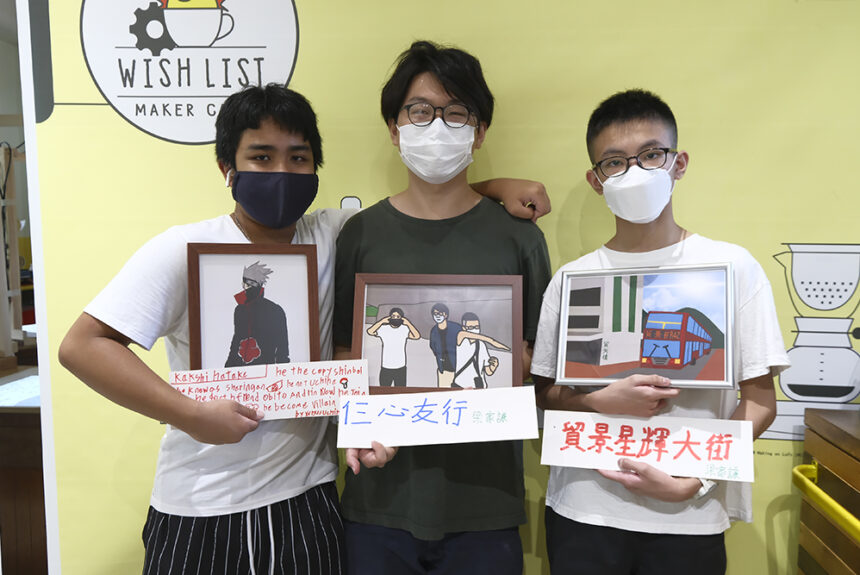
Artists invited by Wheel Thing Makers led students to explore arts through different media. (Photo provided by the interviewee)
Preparation was of particular importance for establishing mutual trust among participating artists and students. In the early stage, three artists were invited to lead the teaching of the six SEN students who joined the programme.
The team first visited the school to get an understanding of the students’ learning environment. A professional psychiatric nurse was invited by the school to share experience with the team.
Inclusion is not to make the other the same as oneself, but to understand each other’s different needs. Katie pointed out that SEN children’s general understanding of language is different and we should not expect their way of communication to be the same as ours.
“A teacher once suggested using other phrases instead of ‘add oil’ as an encouragement to the students as some may think that the phrase means ‘not doing well enough’. We are also learning to understand others’ expressions and emotions,” Katie said.

Katie Yeung, a member of Wheel Thing Makers Creative Society (Photo by Cafe Tong)

The artists conducted online teaching for SEN students, enabling them to explore their creativity in visual arts and design even though they had to stay at home. (Photo provided by the interviewee)
“They were very engaged in making their own ‘visual diary’, recording their daily lives with images. They usually woke up early in the morning and, instead of ‘threw a tantrum’, drew immediately and stayed focused for several hours, then shared pictures to our online group,” Katie said.
The artists conducted six online sessions, covering various materials such as wood blocks, acrylic, charcoal crayons, and oil pastels. The team realised that integration of hardware was very important. In many cases, the students lowered their heads to focus on their work and the camera could only capture the heads. Then, it was necessary to adjust the camera angle or ask the students more questions in order to track everyone’s progress. The students had a keen sense of the characteristics of different creative media. Some refused to use water-based paints, and some liked to draw with their fingers. “Let them try and they will know,” Katie remarked.

We Draw We Talk – Us in Epidemic provides arts education activities for SEN students. (Photo by Cafe Tong)
Playing through virtual and real canvases
From online to offline and in accordance to the latest epidemic prevention measures, Wheel Thing Makers Creative Society organised four face-to-face activities, including artist-led outdoor sketching in West Kowloon Cultural District and a day visit to the Hong Kong Museum of Art. Different environments promoted creativity and helped students develop their unique perspectives.
Katie recalled, “On the day of sketching in West Kowloon Cultural District, most students drew similar compositions – the sky, skyscrapers, and the harbour. A student instead drew a big bird in the middle of the painting as the ‘protagonist’. This unique and different perspective reminded me that we could see the world like this.”
More importantly, arts allow students to express their unspeakable feelings. One of the students in the group had difficulty in speaking after undergoing an operation and for whom the conventional communication method of words and languages was not the best one. The student used visual arts elements as an initial relief, then explained to the carer. It turned out to be a more effective communication and the organisational skills of the student was trained up at the same time.
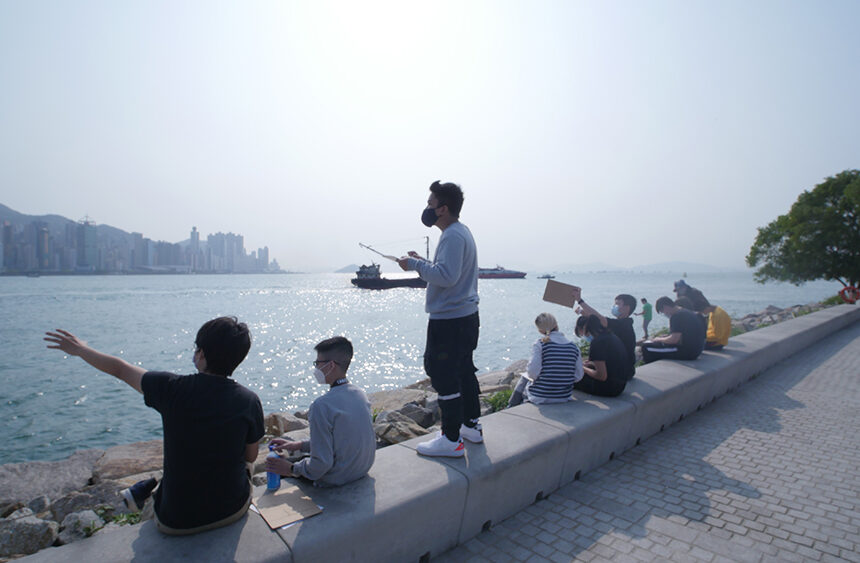
Artists took students to outdoor sketching in West Kowloon Cultural District. Different environments provided stimulus to promote students’ creativity. (Photo provided by the interviewee)

The work of a student Chung Wing-hei after visiting the Hong Kong Museum of Art. (Photo provided by the interviewee)
Wheel Thing Makers Creative Society had always emphasised the hands on creations. In this programme, such a part was incorporated with digital media. A “drawable and playable” device was produced with Touch Design technology. The installation projected animations which were selected from the visual elements created by the students during the 6-month programme, including patterns of water droplets combined with the artist’s work. Students could tap on water droplets, interact in their preferred way or use a brush to paint on the lights and shadows. The computer would track the strokes instantly and record their works.
“Apparently, they like dynamic things that can be touched and played, and we insisted on including some physical elements,” Katie said. This was the second application of Touch Design by Wheel Thing Makers Creative Society which undoubtedly opened up the possibility of multimedia arts. Their creative journey is shared online, and the public can view their works and have a taste of arts by playing the online mini interactive games such as colouring game, robot assembling, and exhibition creation.
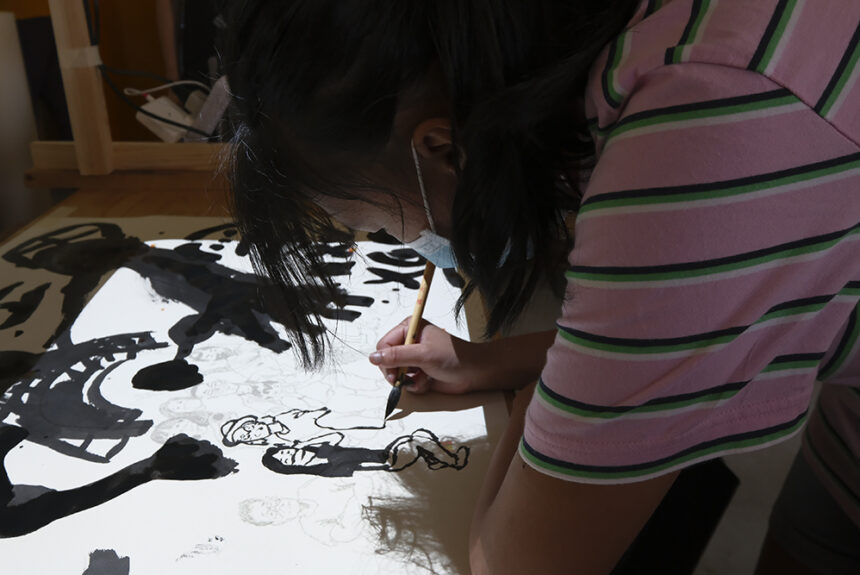
The team used Touch Design technology to produce an interactive installation. (Photo provided by the interviewee)
From self-learning to co-learning
Hong Kong Open Printshop (HKOP) is another arts group going digital to cater the needs of different groups of people. Similar to other visual arts organisations, they explored the possibility of online teaching during the epidemic. However, they found out that many online activities were not supported by arts accessibility services. Hence HKOP joined the “Arts Go Digital Platform Scheme” and looked into all possibilities of integrating arts accessibility services.
In cooperation with Arts with the Disabled Association Hong Kong and Chinese YMCA of Hong Kong-Y’s Men’s Centre for the Deaf, HKOP first launched the “Graphic Art Archive” with audio description.
Chung Sin-wa, Production Officer of HKOP, said that museums and arts organisations around the world had been actively moving towards open access to their resources in recent years. They digitised their collections, even opened access rights for the images, and promoted information and educational exchanges.
Established in 2000, HKOP has over the years accumulated a rich collection of more than a thousand items, including works donated by artists, artworks in HKOP Award in Printmaking, etc. The first batch of more than 100 sets of artworks had been uploaded to the online archive, with audio description to be applied in phases. At present, 20 sets of works are attached with text content of audio description. Visually impaired people can comprehend the collection with the use of screen readers.
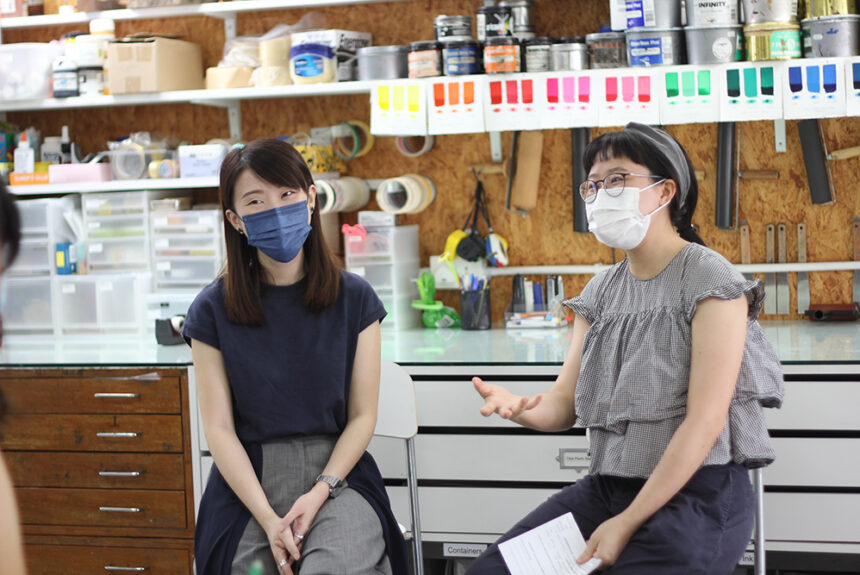
Loraine Wong (left) and Chung Sin-wa from Hong Kong Open Printshop. (Photo by Cafe Tong)
“In the visual arts sector in Hong Kong, arts accessibility services are usually applied in guided visits or artwork descriptions in exhibitions. However, we believe that workshops are also worth sign language interpretation,” said Loraine Wong, Programme Manager of HKOP. She wished that while staying at home during the pandemic, people with different needs could still learn more about printmaking.
There were five teaching videos available for self-learning, each with subtitles, sign language interpretation and audio description. These pre-recorded videos were demonstrated by young artists, providing introductions of basic techniques of printmaking. For co-learning, six live demonstrations and six charged online workshops on stencil printing, drypoint, linocut, book binding and other techniques were conducted, for which simultaneous sign language interpretation were provided in cooperation with Y’s Men’s Centre for the Deaf. A material kit of each workshop would be sent to participants by mail beforehand.
“Wwe have organised special guided tours with arts accessibility services before. In this programme, we made a fresh attempt: no separate classes were held for the hearing impaired, instead everybody did it together and learnt from one another,” said Loraine.

Loraine said that HKOP could not afford to hire a production company to shoot 12 live demonstrations and workshops. They had to rely on their own staff to handle the live broadcasts. Every shooting took them nearly half a day for the set-up. (Photo provided by the interviewee)
First ever online workshop of this kind
“One of the challenges of doing an online workshop with sign language interpretation is that printmaking involves many technical terms. Some of which have never been translated into sign language hence the interpreters cannot sign at once. For example, how should ‘ferric chloride’ used in copper engraving be translated into sign language?” Sin-wa said.
Y’s Men’s Centre for the Deaf provided sign language interpreters for the workshops and HKOP offered some printmaking workshop quotas to hearing impaired members of the Centre in exchange. Collaboration provided solutions to all kinds of difficulties.
“What we learnt from the collaboration was that rehearsal was very important for the smooth running of the demonstrations and workshops. When interpreters have gone through the whole process and known the words that are difficult to sign in the rehearsal, they could discuss and research more to solve the problems. Sometimes they showed a whiteboard with specific terms so that participants can easily understand. We were like crossing the river by feeling the stones,” Sin-wa concluded.
As the workshops were conducted online, the size of the sign language interpreter shown on the screen had to be taken into consideration. Making prints needed a lot of tools and that would take up a lot of space on the screen. If the size of the sign language interpreter on the screen was too small, it would be difficult for users to see the signs clearly. In addition, the artists had to ensure the sign language interpreters were able to follow the speaking speed. Complicated steps should be broken down and explained clearly. Sin-wa said that HKOP did not take the lead in arts accessibility, but rather walked shoulder-to-shoulder with service users.

A material kit for each workshop was delivered to participants by mail, and real-time teaching was conducted on the online platform. (Photo by Cafe Tong)
“Many details in operation were actually tried and worked out by all members together!” Loraine said. “The feel of the hands is essential to printmaking, that is, the touch. Hence it is apt for hearing or visually impaired people to express their views with prints.”
Summing up, they opened a material kit and explained the usage of each gadget to us smoothly. Additional materials were included in the kit so that participants could rewatch the video clips and try again. There was also information about shops where these materials could be purchased and it was easy for anyone to get the necessary materials to DIY.
The endeavours of these two arts organisations proved that going online did not mean to add just lifeless optic fibres between users and the arts; but a connection across the virtual and reality was made possible through creation. Arts accessibility enabled everyone to participate in the creative process regardless of their differences in needs. The artworks kept the remaining temperature of the hands, and that was the warmth.
Related Projects :
- “HKOP Printin’ Online” : Experience now / Learn more
- “We Draw We Talk – Us in Epidemic” : Experience now / Learn more
